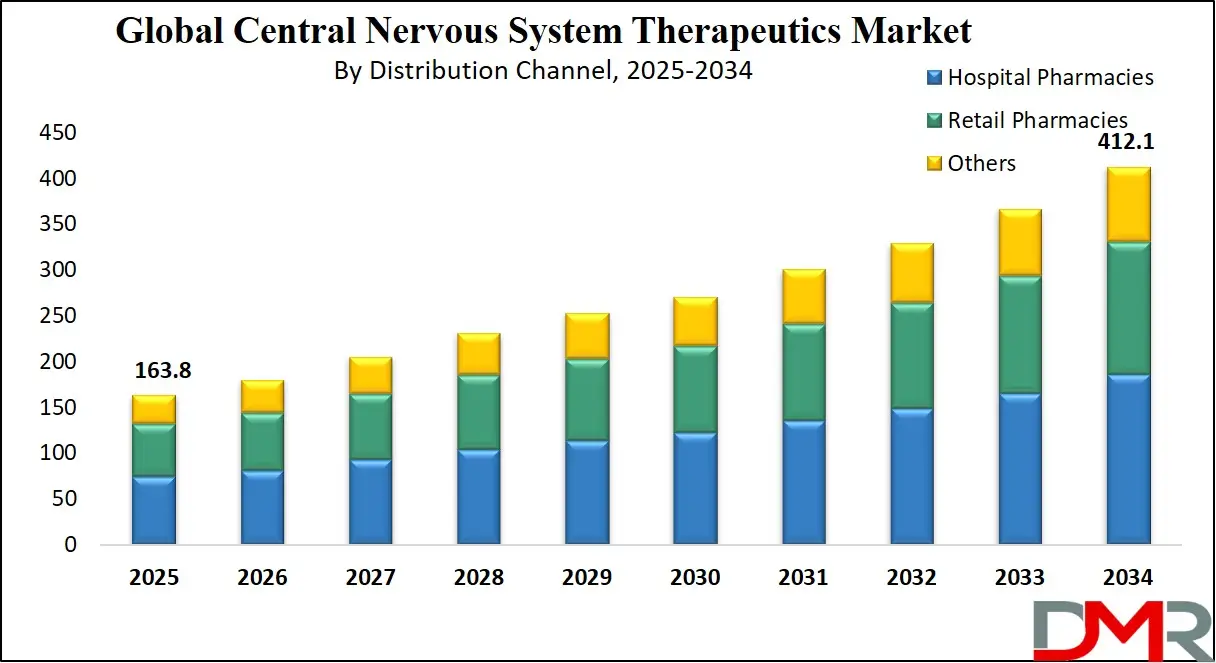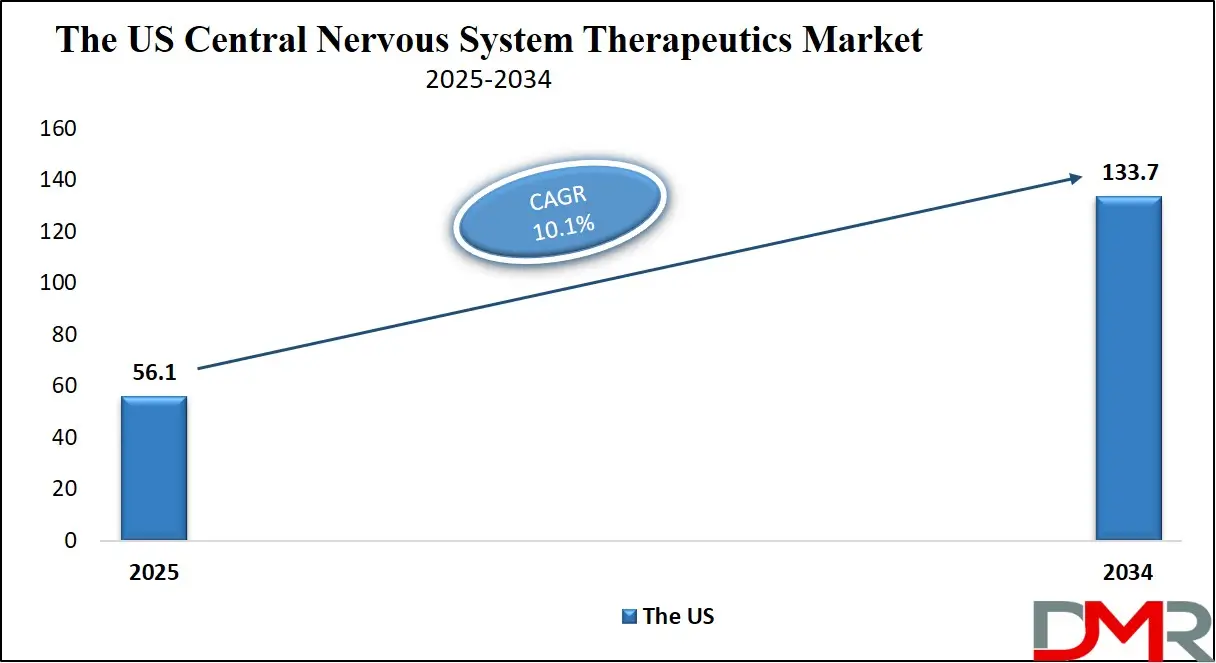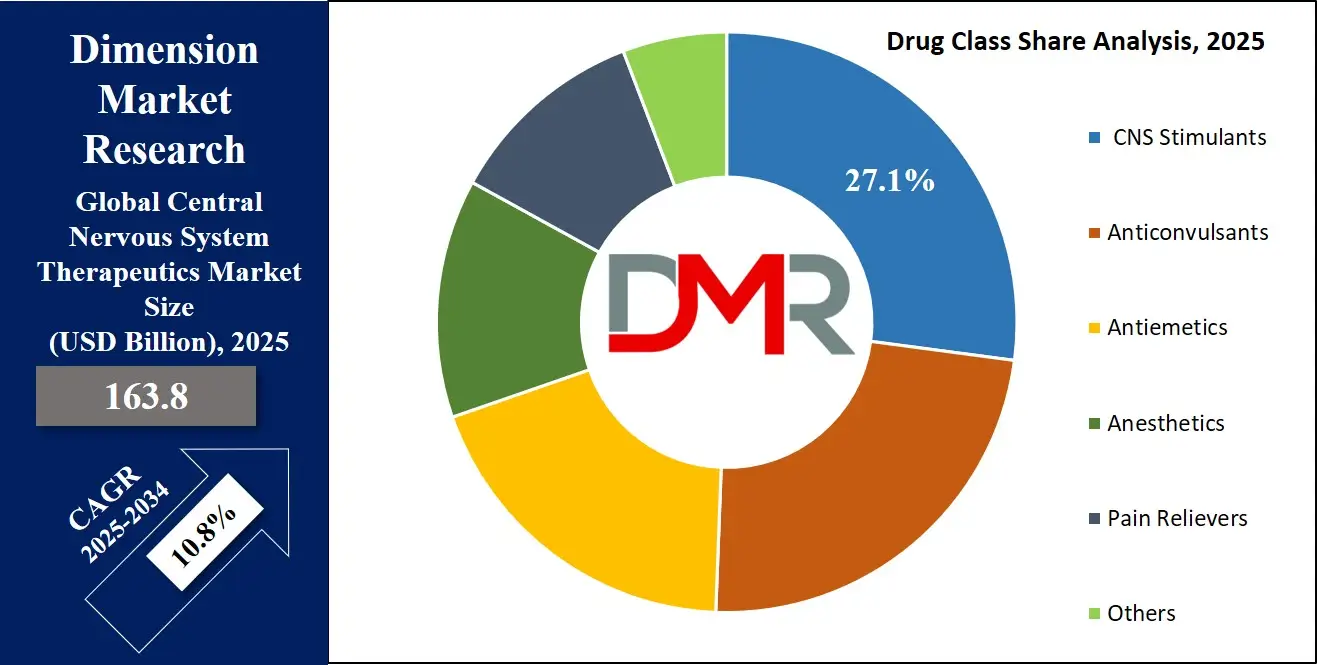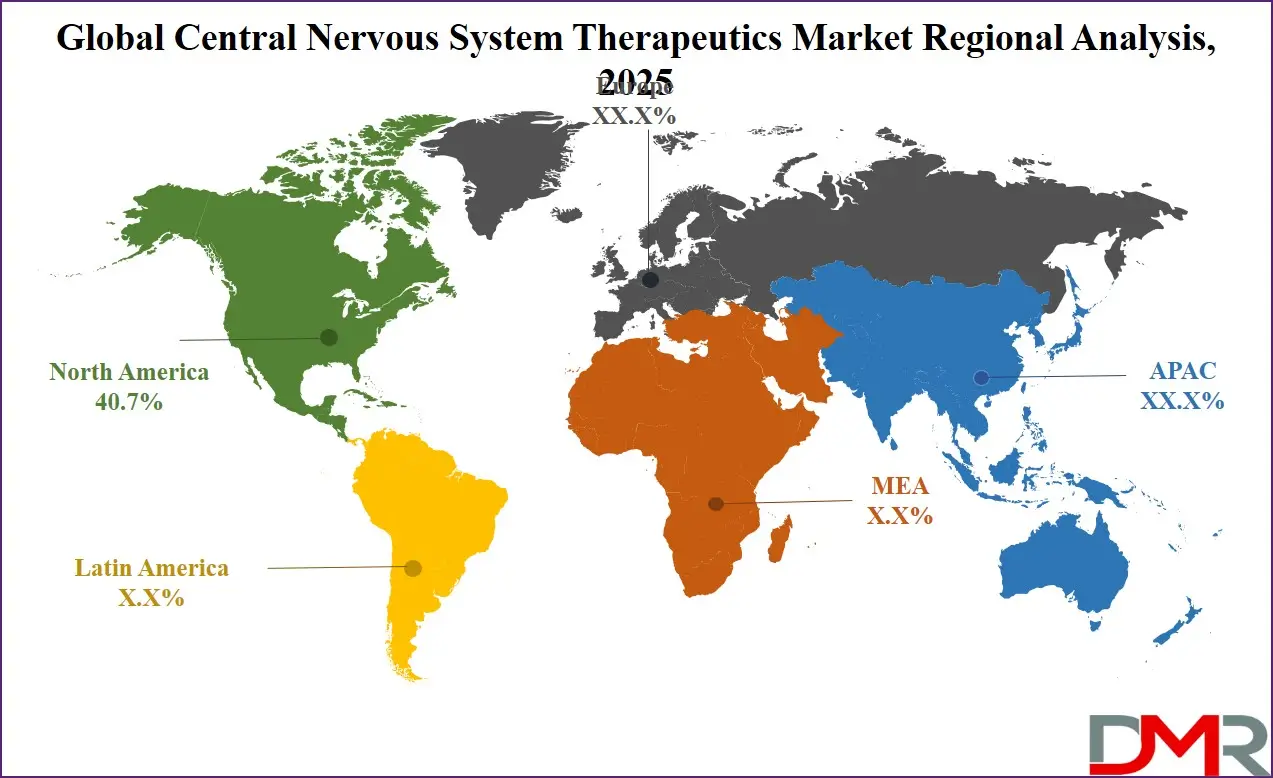Market Overview
The Global Central Nervous System (CNS) Therapeutics Market is predicted to be valued at USD 163.8 billion in 2025 and is expected to grow to USD 412.1 billion by 2034, registering a CAGR of 10.8% from 2025 to 2034.
Central Nervous System (CNS) therapeutics encompass a range of treatments aimed at managing disorders affecting the brain and spinal cord. These therapies address conditions such as Alzheimer's disease, Parkinson's disease, epilepsy, depression, schizophrenia, and brain tumors. Treatment modalities include small molecule drugs, biologics, gene therapies, and regenerative approaches.

Advancements in drug delivery systems, such as utilizing peripheral immune cells to cross the blood-brain barrier, have enhanced the effectiveness of these treatments. The global CNS therapeutics market is experiencing significant growth, driven by an aging population and increased prevalence of neurological disorders.
Central Nervous System (CNS) therapeutics market growth has been spurred by demographic, social, and technological factors. One key driver is an aging global population whose life expectancies increase along with prevalence rates of age-related neurodegenerative conditions like Alzheimer's and Parkinson's; older adults are particularly prone to these conditions. As life expectancies rise, there is also an increase in prevalence rate, which necessitates effective treatment options. It not only changes the compound healthcare burden but also opens lucrative opportunities within the CNS therapeutics industry.
Due to an increasing incidence of central nervous system (CNS) disorders, healthcare systems worldwide must adopt innovative treatments to manage and treat those affected by complex neurological and psychiatric diseases. As a response, pharmaceutical companies have undertaken intensive research in CNS therapeutics, focusing on drug delivery systems, neuroprotective agents and disease-modifying treatments - pushing their R&D departments in this arena are moving forward rapidly.
Consistent with this trend is an increasing societal awareness of mental health. Stigma surrounding disorders like depression and anxiety has slowly been dismantling, opening the way for more open discussions on mental wellness as a priority in healthcare policies, reimbursement strategies and consumer behavior; all which impact CNS therapeutic demand expansion - with mental health treatments taking their rightful place alongside neurodegenerative disease therapies as part of this market landscape diversification effort.
Opportunities in the CNS therapeutics market have been exponentially expanded by technological developments. Breakthroughs in molecular biology, neurology, neuroimaging, genetic engineering, and precision medicine are making possible more targeted and personalized therapies; emerging treatment modalities including gene therapy, stem cell therapy and precision medicine, hold incredible promise to revolutionize management of CNS disorders while drawing substantial investment and collaboration between biotech firms and research institutions.

The US Central Nervous System Therapeutics Market
The US Global Central Nervous System (CNS) Therapeutics is projected to be valued at USD 56.1 billion in 2025. It is expected to witness subsequent growth in the upcoming period as it holds USD 133.7 billion in 2034 at a CAGR of 10.1%.
The primary driving factor of the U.S. central nervous system (CNS) therapeutics market is the increasing prevalence of neurological disorders, particularly Alzheimer’s and Parkinson’s diseases, largely due to an aging population. The U.S. boasts a strong healthcare infrastructure, enabling timely diagnosis and treatment. Significant investments in research and development from both public and private sectors support the discovery of advanced therapies.
Moreover, regulatory support for novel drug approvals and the presence of key pharmaceutical companies contribute to rapid innovation and accessibility, ultimately boosting the demand and growth of CNS therapeutic options across the nation.
A major trend in the U.S. CNS therapeutics market is the shift toward precision medicine and targeted therapies, utilizing biomarkers and genetic profiling for more effective treatments. There's also growing adoption of digital therapeutics and AI-based tools for early diagnosis and monitoring.
Additionally, the development of disease-modifying therapies for neurodegenerative conditions is gaining momentum, offering hope beyond symptom management. Biologic drugs, including monoclonal antibodies, are becoming increasingly prevalent. Strategic partnerships between biotech firms and large pharmaceutical companies are also rising, accelerating innovation pipelines and expanding treatment options for complex CNS disorders in the U.S. market.

Central Nervous System Therapeutics Market: Key Takeaways
- Global Market Outlook: The Global Central Nervous System (CNS) Therapeutics Market is projected to be valued at USD 163.8 billion in 2025 and is expected to grow significantly to USD 412.1 billion by 2034, registering a compound annual growth rate (CAGR) of 10.8% during the forecast period.
- U.S. Market Outlook: The U.S. CNS Therapeutics Market is anticipated to reach a value of USD 56.1 billion in 2025, and continue expanding to USD 133.7 billion by 2034, at a CAGR of 10.1%.
- Disease Segment Analysis: Mental health disorders are expected to dominate the CNS therapeutics market, capturing a 43.3% revenue share by the end of 2025. This is primarily due to their increasing prevalence on a global scale.
- Drug Type Analysis: CNS stimulants are projected to hold the largest revenue share in 2025, accounting for 27.1% of the market. This growth is driven by the rising incidence of conditions such as ADHD, narcolepsy, and other attention-related disorders.
- Distribution Channel Analysis: Hospital pharmacies are expected to lead the distribution segment of the CNS therapeutics market, holding the highest revenue share by the end of 2025.
- Regional Market Insights: North America is projected to dominate the global CNS therapeutics market, accounting for a 40.7% revenue share by 2025, supported by robust healthcare infrastructure and high demand for CNS-related treatments.
Central Nervous System Therapeutics Market: Use Cases
- Treatment of Neurodegenerative Diseases: The CNS therapeutics market plays a vital role in managing neurodegenerative diseases such as Alzheimer’s, Parkinson’s, and Huntington’s disease. These conditions progressively deteriorate brain function, affecting memory, movement, and cognition. CNS drugs help by slowing the progression of these diseases and alleviating symptoms.
- Management of Mental Health Disorders: CNS therapeutics are essential in treating a wide range of mental health disorders, including depression, anxiety, bipolar disorder, and schizophrenia. These conditions stem from imbalances in brain chemistry, and CNS-targeted drugs work to restore that balance.
- Pain Management for Neuropathic and Chronic Conditions: Disorders like fibromyalgia, post-herpetic neuralgia, and multiple sclerosis can lead to persistent pain due to nerve dysfunction. CNS drugs help modulate the way pain is processed in the brain and spinal cord. Medications like pregabalin, duloxetine, and tricyclic antidepressants are often prescribed to reduce nerve pain and improve patient comfort.
- Control and Prevention of Epileptic Seizures: CNS therapeutics are also widely used in the treatment of epilepsy and seizure-related disorders. These drugs work by stabilizing electrical activity in the brain, preventing the abnormal bursts that lead to seizures. Antiepileptic medications such as valproate, levetiracetam, and lamotrigine are effective in reducing seizure frequency and severity.
Central Nervous System Therapeutics Market: Market Dynamics
Driving Factors in the Central Nervous System Therapeutics Market
Aging Population and Rising CNS Disorders
The global population is aging at an unprecedented rate, with individuals aged 60 and above projected to reach 2.1 billion by 2050. This demographic shift is contributing to a marked increase in age-related central nervous system (CNS) disorders such as Alzheimer’s disease, Parkinson’s disease, and dementia. Older adults are more susceptible to neurodegenerative conditions due to the natural decline in neuronal function over time. This surge in prevalence is creating an urgent need for effective CNS therapeutics that can manage or slow disease progression. Consequently, pharmaceutical companies are investing heavily in research and development to meet this growing demand.
Advancements in Precision Medicine
The rise of precision medicine has significantly transformed the landscape of CNS therapeutics. By leveraging genomic insights and molecular diagnostics, researchers can now develop personalized treatment plans based on a patient’s unique genetic makeup. Tools like pharmacogenomics and biomarker profiling are helping predict patient responses to medications, thereby reducing trial-and-error approaches and minimizing adverse effects. This customization enhances the efficacy and safety of CNS treatments, especially in complex conditions like epilepsy, schizophrenia, and multiple sclerosis. These innovations not only improve patient outcomes but also open up new commercial opportunities, encouraging pharmaceutical companies to focus on targeted CNS drug development.
Restraints in the Central Nervous System Therapeutics Market
High Development Costs and Regulatory Hurdles
The development of CNS therapeutics is an expensive and time-consuming endeavor, often requiring billions of dollars in investment and over a decade of research. The complexity of brain functions and neurological pathways demands rigorous and long-term clinical trials to establish drug safety and efficacy.
Additionally, CNS drugs must meet stringent regulatory standards set by agencies such as the FDA and EMA, which often require additional data and post-market surveillance. These barriers can delay or even prevent drug approval and market entry. The financial and regulatory burdens thus act as major restraints on innovation and commercial viability in the CNS therapeutics market.
Limited Understanding of CNS Pathophysiology
Despite ongoing research, the central nervous system remains one of the least understood areas of human biology. Many CNS disorders—such as schizophrenia, bipolar disorder, and Alzheimer’s disease—lack clear biomarkers or fully understood disease mechanisms. This limited understanding makes it difficult to develop effective and targeted therapies. As a result, many drug candidates fail during clinical trials due to unforeseen side effects or inadequate efficacy. This high failure rate discourages investment and reduces the number of new drugs entering the pipeline. Consequently, the knowledge gap in CNS pathophysiology significantly impedes progress in therapeutic development and innovation.
Opportunities in the Central Nervous System Therapeutics Market
Emerging Markets Expansion
Emerging economies such as China, India, and Brazil offer vast untapped potential for the CNS therapeutics market. These countries are experiencing rapid population growth, urbanization, and increased life expectancy. All of these factors contribute to a rise in CNS-related conditions like epilepsy, depression, and Alzheimer's disease. With rising healthcare expenditures, improving infrastructure, and growing awareness of mental and neurological health, demand for effective treatments is accelerating.
Additionally, governments in these regions are investing in healthcare reforms and public health initiatives, encouraging foreign pharmaceutical companies to enter these markets. This expansion presents lucrative opportunities for global players to scale operations and diversify revenue streams.
Development of Disease-Modifying Therapies
While many current CNS drugs focus on symptom management, there is a growing demand for disease-modifying therapies that address the underlying causes of neurological disorders. This shift is particularly urgent in conditions like Alzheimer's, Parkinson's, and multiple sclerosis, where existing treatments offer only temporary relief. Advances in biologics, gene therapies, and regenerative medicine are opening doors to new approaches that can potentially halt or reverse disease progression. These cutting-edge therapies hold promise not only for improved patient outcomes but also for reshaping treatment protocols. Their development represents a significant commercial and clinical opportunity for pharmaceutical companies committed to innovation in CNS care.
Trends in the Central Nervous System Therapeutics Market
Integration of Digital Therapeutics and AI
The CNS therapeutics landscape is rapidly evolving with the integration of digital therapeutics and artificial intelligence (AI). Digital tools like mobile apps, wearable devices, and telemedicine platforms are being used to monitor patient behavior, improve treatment adherence, and collect real-time data on symptoms. Meanwhile, AI is playing a crucial role in accelerating drug discovery by analyzing complex datasets to identify potential drug candidates, predict treatment outcomes, and optimize clinical trial designs. These technologies are not only improving efficiency and reducing R&D costs but also enabling more personalized and proactive approaches to managing CNS disorders, ultimately transforming patient care.
Strategic Collaborations and Partnerships
The CNS therapeutics market is seeing a surge in strategic collaborations and mergers aimed at accelerating innovation and expanding treatment portfolios. Pharmaceutical giants are partnering with biotech firms, academic institutions, and digital health companies to leverage complementary expertise and resources. A prime example is Johnson & Johnson's USD 15 billion acquisition of Intra-Cellular Therapies, which enhances its focus on mental health and neurological disorders. Such partnerships help share financial risks, fast-track research, and improve access to advanced technologies. This trend underscores a shift toward more collaborative ecosystems in drug development, fostering innovation and expediting the availability of novel CNS therapies worldwide.
Central Nervous System Therapeutics Market: Research Scope and Analysis
By Disease Analysis
Mental health diseases are predicted to dominate the Central Nervous System (CNS) therapeutics market with a revenue share of 43.3% by the end of 2025, due to their high and growing global prevalence. Disorders like anxiety, depression, and schizophrenia affect millions and are increasingly recognized and diagnosed. Rising awareness, reduced stigma, and greater access to healthcare services have amplified treatment demand. The aging population further contributes to mental health challenges, necessitating ongoing management. Pharmaceutical companies are heavily investing in novel therapies and improved drug delivery systems, enhancing treatment effectiveness.
Neurodegenerative diseases are expected to experience the fastest growth in the CNS therapeutics market, with a projected high CAGR. This surge is driven by the increasing global burden of disorders like Alzheimer’s, Parkinson’s, and multiple sclerosis, particularly among the aging population. As life expectancy rises, so does the incidence of these chronic and debilitating conditions. The urgent need for disease-modifying treatments has spurred substantial investments in research and development. Advances in biomarkers, precision medicine, and neurotechnology are accelerating therapeutic innovations. As a result, the neurodegenerative segment is poised for significant expansion to meet the unmet medical needs of this population.
By Drug Class Analysis
CNS stimulants are predicted to dominate the Central Nervous System (CNS) therapeutics market due to rising cases of ADHD, narcolepsy, and other attention-related disorders. In 2025, they held the largest revenue share at 27.1%, driven by growing awareness of mental health, improved diagnostic rates, and new drug approvals expanding treatment options. Additionally, the increased recognition of sleep-related conditions like obstructive sleep apnea is boosting demand. These factors, combined with enhanced accessibility and physician preference for stimulant-based treatments, contribute to their leading market position.
Anticonvulsants are expected to experience high growth, with a projected high CAGR, due to the global burden of epilepsy affecting nearly 50 million people. Growing demand for effective seizure control therapies, coupled with technological and pharmaceutical advancements, is driving the segment. Moreover, increased awareness, early diagnosis, and the expiration of patents on key drugs are fostering the entry of cost-effective generics. These trends are making treatments more accessible across various demographics, particularly in developing regions, further propelling the growth of the anticonvulsant segment in the CNS therapeutics market.

By Distribution Channel Analysis
Hospital pharmacies are anticipated to dominate the Central Nervous System (CNS) therapeutics market with the highest revenue share by the end of 2025, due to their crucial role in delivering acute care and specialized treatments, particularly for complex CNS disorders. Hospitals provide immediate access to medications, continuous patient monitoring, and expert management, making them essential for treating serious and complex neurological conditions.
Moreover, the integration of Remote Patient Monitoring (RPM) further strengthens hospital pharmacies' ability to track patients beyond clinical settings, enabling better adherence, timely interventions, and improved outcomes. As CNS disorders rise, hospital pharmacies, supported by remote monitoring technologies, are well-equipped to meet the growing demand for these therapeutic interventions, thus maintaining their dominant market share.
Retail pharmacies are expected to experience high growth due to the increasing shift towards outpatient care and telemedicine. They offer convenient access to prescription refills and routine CNS condition management, supporting patients' long-term health needs. Furthermore, the expansion of community-based mental health services and decentralized healthcare models fosters retail pharmacy growth, with competitive pricing and discounts appealing to patients seeking affordable treatment options.
The Central Nervous System Therapeutics Market Report is segmented on the basis of the following:
By Disease
- Neurovascular Diseases
- CNS Trauma
- Mental Health
- Anxiety Disorders
- Epilepsy
- Mood Disorders
- Psychotic Disorders
- Others
- Neurodegenerative Diseases
- Alzheimer’s Disease
- Parkinson’s Disease
- Multiple Sclerosis
- Huntington’s Disease
- Amytrophic Lateral Sclerosis
- Others
- Infectious Diseases
- CNS Cancer
- Others
By Drug Class
- Anesthetics
- Anticonvulsants
- Antiemetics
- CNS Stimulants
- Pain Relievers
- Others
By Distribution Channel
- Hospital Pharmacies
- Retail Pharmacies
- Others
Regional Analysis
Region with the largest Share
North America is predicted to dominate the Central Nervous System (CNS) Therapeutics Market with a revenue share of 40.7% by the end of 2025, due to its advanced healthcare infrastructure, high healthcare spending, and significant prevalence of neurological and mental health disorders. The region benefits from a strong presence of leading pharmaceutical companies, robust research and development activities, and early adoption of innovative treatment solutions. Government support and high awareness levels among the population further fuel market demand. The availability of skilled professionals and favorable reimbursement policies also contribute to the region’s leadership.

Region with Highest CAGR
The Asia Pacific region is expected to experience a high CAGR in the market during the forecast period, driven by rising healthcare investments and growing awareness of mental health issues. Countries such as China and India have large populations with unmet medical needs and are rapidly expanding their pharmaceutical sectors. Modernization of healthcare infrastructure, increased government initiatives, and improved access to CNS treatments support market growth. In China, the focus on biologics and treatment innovations for conditions like Parkinson’s disease is boosting its market share, establishing the region as a growth hub for CNS therapeutics.
By Region
North America
Europe
- Germany
- The U.K.
- France
- Italy
- Russia
- Spain
- Benelux
- Nordic
- Rest of Europe
Asia-Pacific
- China
- Japan
- South Korea
- India
- ANZ
- ASEAN
- Rest of Asia-Pacific
Latin America
- Brazil
- Mexico
- Argentina
- Colombia
- Rest of Latin America
Middle East & Africa
- Saudi Arabia
- UAE
- South Africa
- Israel
- Egypt
- Rest of MEA
Competitive Landscape
The global Central Nervous System (CNS) therapeutics market is highly competitive, driven by the rising prevalence of neurological disorders such as Alzheimer's disease, Parkinson's disease, multiple sclerosis, epilepsy, and depression. Key pharmaceutical giants like Pfizer, Johnson & Johnson, Novartis, Eli Lilly, and Biogen dominate the landscape with extensive product pipelines, strong R&D capabilities, and established global distribution networks.
The market is also witnessing increased competition from emerging biopharmaceutical companies and generics manufacturers, particularly in the treatment of chronic CNS conditions. Strategic collaborations, mergers, and acquisitions are common as firms aim to bolster their portfolios and accelerate drug development. Technological advancements, including biomarker research and personalized medicine, are fostering innovation and offering a competitive edge.
Additionally, the patent expiration of blockbuster drugs has opened opportunities for biosimilars, intensifying price competition. Regulatory challenges and high costs of drug development, especially for CNS conditions with complex pathophysiology, remain key hurdles. Despite these barriers, the demand for effective CNS therapies continues to grow, spurred by aging populations and heightened awareness of mental health. Overall, the CNS therapeutics market remains dynamic, with innovation and strategic partnerships playing crucial roles in shaping its competitive landscape.
Some of the prominent players in the Global Central Nervous System Therapeutics Market are:
- Biogen
- Otsuka Pharmaceutical Co., Ltd.
- Eli Lilly and Company
- Merck & Co., Inc.
- Astra Zeneca
- Takeda Pharmaceutical Company Limited
- Novartis AG
- Teva Pharmaceutical Industries Ltd
- Johnson & Johnson Services, Inc.
- Pfizer Inc.
- Roche Holding AG (F. Hoffmann-La Roche Ltd.)
- Sanofi S.A.
- GlaxoSmithKline plc (GSK)
- Bristol-Myers Squibb Company
- AbbVie Inc.
- UCB S.A.
- Jazz Pharmaceuticals plc
- Lundbeck A/S
- Neurocrine Biosciences, Inc.
- Amgen Inc.
- Other Key Players
Recent Developments
- In May 2024, AC Immune and Takeda formed an exclusive partnership for the Alzheimer’s immunotherapy ACI-24.060. The deal includes an upfront payment of $100 million and could reach over USD 2.1 billion with milestone payments.
- In March 2024, the FDA approved Ultomiris as the first long-acting C5 complement inhibitor for adults with anti-AQP4 antibody-positive NMOSD, showing a strong reduction in relapse rates.
- In January 2024, Biogen shifted its strategic focus toward LEQEMBI, discontinuing the development of ADUHELM. This decision was based on a realignment of priorities rather than concerns about safety or efficacy.
Report Details
| Report Characteristics |
| Market Size (2025) |
USD 163.8 Bn |
| Forecast Value (2034) |
USD 412.1 Bn |
| CAGR (2025–2034) |
10.8% |
| Historical Data |
2019 – 2024 |
| The US Market Size (2025) |
USD 56.1 Bn |
| Forecast Data |
2025 – 2033 |
| Base Year |
2024 |
| Estimate Year |
2025 |
| Report Coverage |
Market Revenue Estimation, Market Dynamics, Competitive Landscape, Growth Factors, etc. |
| Segments Covered |
By Disease (Neurovascular Diseases, CNS Trauma, Mental Health, Neurodegenerative Diseases, Infectious Diseases, CNS Cancer, and Others), By Drug Class (Anesthetic, Anticonvulsants, Antiemetics, CNS Stimulants, Pain Relievers, and Others), By Distribution Channel (Hospital Pharmacies, Retail Pharmacies, and Others) |
| Regional Coverage |
North America – US, Canada; Europe – Germany, UK, France, Russia, Spain, Italy, Benelux, Nordic, Rest of Europe; Asia-Pacific – China, Japan, South Korea, India, ANZ, ASEAN, Rest of APAC; Latin America – Brazil, Mexico, Argentina, Colombia, Rest of Latin America; Middle East & Africa – Saudi Arabia, UAE, South Africa, Turkey, Egypt, Israel, Rest of MEA |
| Prominent Players |
Biogen, Otsuka Pharmaceutical Co. Ltd., Eli Lilly and Company, Merck & Co. Inc., Astra Zeneca, Takeda Pharmaceutical Company Limited, Novartis AG, Teva Pharmaceutical Industries Ltd, Johnson & Johnson Services, Inc., Pfizer Inc., Roche Holding AG (F. Hoffmann-La Roche Ltd.), Sanofi S.A., GlaxoSmithKline plc (GSK), Bristol-Myers Squibb Company, AbbVie Inc., UCB S.A., Jazz Pharmaceuticals plc, Lundbeck A/S, Neurocrine Biosciences Inc., Amgen Inc., and Other Key Players |
| Purchase Options |
We have three licenses to opt for: Single User License (Limited to 1 user), Multi-User License (Up to 5 Users), and Corporate Use License (Unlimited User) along with free report customization equivalent to 0 analyst working days, 3 analysts working days, and 5 analysts working days respectively. |
Frequently Asked Questions
The Global Central Nervous System Therapeutics Market size is estimated to have a value of USD 163.8 billion in 2025 and is expected to reach USD 412.1 billion by the end of 2034.
North America is expected to be the largest market share for the Global Central Nervous System Therapeutics Market with a share of about 40.7% in 2025.
Some of the major key players in the Global Central Nervous System Therapeutics Market are
Biogen, Eli Lilly and Company, Roche Holding AG (F. Hoffmann-La Roche Ltd.) and many others.
The market is growing at a CAGR of 10.8 percent over the forecasted period.
The US Central Nervous System Therapeutics Market size is estimated to have a value of USD 56.1 billion in 2025 and is expected to reach USD 133.7 billion by the end of 2034.